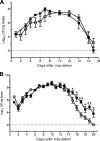RegA, an AraC-like protein, is a global transcriptional regulator that controls virulence gene expression in Citrobacter rodentium
- PMID: 18765720
- PMCID: PMC2573378
- DOI: 10.1128/IAI.00770-08
RegA, an AraC-like protein, is a global transcriptional regulator that controls virulence gene expression in Citrobacter rodentium
Abstract
Citrobacter rodentium is an attaching and effacing pathogen which causes transmissible colonic hyperplasia in mice. Infection with C. rodentium serves as a model for infection of humans with enteropathogenic and enterohemorrhagic Escherichia coli. To identify novel colonization factors of C. rodentium, we screened a signature-tagged mutant library of C. rodentium in mice. One noncolonizing mutant had a single transposon insertion in an open reading frame (ORF) which we designated regA because of its homology to genes encoding members of the AraC family of transcriptional regulators. Deletion of regA in C. rodentium resulted in markedly reduced colonization of the mouse intestine. Examination of lacZ transcriptional fusions using promoter regions of known and putative virulence-associated genes of C. rodentium revealed that RegA strongly stimulated transcription of two newly identified genes located close to regA, which we designated adcA and kfcC. The cloned adcA gene conferred autoaggregation and adherence to mammalian cells to E. coli strain DH5alpha, and a kfc mutation led to a reduction in the duration of intestinal colonization, but the kfc mutant was far less attenuated than the regA mutant. These results indicated that other genes of C. rodentium whose expression required activation by RegA were required for colonization. Microarray analysis revealed a number of RegA-regulated ORFs encoding proteins homologous to known colonization factors. Transcription of these putative virulence determinants was activated by RegA only in the presence of sodium bicarbonate. Taken together, these results show that RegA is a global regulator of virulence in C. rodentium which activates factors that are required for intestinal colonization.
Figures






Similar articles
-
Evolutionary adaptation of an AraC-like regulatory protein in Citrobacter rodentium and Escherichia species.Infect Immun. 2015 Apr;83(4):1384-95. doi: 10.1128/IAI.02697-14. Epub 2015 Jan 26. Infect Immun. 2015. PMID: 25624355 Free PMC article.
-
Autogenous transcriptional regulation of the regA gene, encoding an AraC-Like, essential virulence regulator in Citrobacter rodentium.J Bacteriol. 2011 Apr;193(7):1777-82. doi: 10.1128/JB.01224-10. Epub 2011 Jan 28. J Bacteriol. 2011. PMID: 21278290 Free PMC article.
-
Bicarbonate-mediated transcriptional activation of divergent operons by the virulence regulatory protein, RegA, from Citrobacter rodentium.Mol Microbiol. 2008 Apr;68(2):314-27. doi: 10.1111/j.1365-2958.2008.06171.x. Epub 2008 Feb 19. Mol Microbiol. 2008. PMID: 18284589
-
Virulence regulation in Citrobacter rodentium: the art of timing.Microb Biotechnol. 2010 May;3(3):259-68. doi: 10.1111/j.1751-7915.2009.00114.x. Epub 2009 Apr 16. Microb Biotechnol. 2010. PMID: 21255326 Free PMC article. Review.
-
Citrobacter rodentium of mice and man.Cell Microbiol. 2005 Dec;7(12):1697-706. doi: 10.1111/j.1462-5822.2005.00625.x. Cell Microbiol. 2005. PMID: 16309456 Review.
Cited by
-
From ingestion to colonization: the influence of the host environment on regulation of the LEE encoded type III secretion system in enterohaemorrhagic Escherichia coli.Front Microbiol. 2015 Jun 5;6:568. doi: 10.3389/fmicb.2015.00568. eCollection 2015. Front Microbiol. 2015. PMID: 26097473 Free PMC article. Review.
-
Genome-wide analysis of the Pho regulon in a pstCA mutant of Citrobacter rodentium.PLoS One. 2012;7(11):e50682. doi: 10.1371/journal.pone.0050682. Epub 2012 Nov 30. PLoS One. 2012. PMID: 23226353 Free PMC article.
-
Inducible transposon mutagenesis identifies bacterial fitness determinants during infection in mice.Nat Microbiol. 2025 May;10(5):1171-1183. doi: 10.1038/s41564-025-01975-z. Epub 2025 Mar 27. Nat Microbiol. 2025. PMID: 40148565 Free PMC article.
-
Host-associated niche metabolism controls enteric infection through fine-tuning the regulation of type 3 secretion.Nat Commun. 2018 Oct 10;9(1):4187. doi: 10.1038/s41467-018-06701-4. Nat Commun. 2018. PMID: 30305622 Free PMC article.
-
Quantitative dose-response analysis untangles host bottlenecks to enteric infection.Nat Commun. 2023 Jan 28;14(1):456. doi: 10.1038/s41467-023-36162-3. Nat Commun. 2023. PMID: 36709326 Free PMC article.
References
-
- Autret, N., and A. Charbit. 2005. Lessons from signature-tagged mutagenesis on the infectious mechanisms of pathogenic bacteria. FEMS Microbiol. Rev. 29703-717. - PubMed
-
- Barthold, S. W. 1980. The microbiology of transmissible murine colonic hyperplasia. Lab. Anim. Sci. 30167-173. - PubMed
-
- Benz, I., and M. A. Schmidt. 1990. Diffuse adherence of enteropathogenic Escherichia coli strains. Res. Microbiol. 141785-786. - PubMed
-
- Bhakdi, S., N. Mackman, G. Menestrina, L. Gray, F. Hugo, W. Seeger, and I. B. Holland. 1988. The hemolysin of Escherichia coli. Eur. J. Epidemiol. 4135-143. - PubMed
Publication types
MeSH terms
Substances
Associated data
- Actions
LinkOut - more resources
Full Text Sources
Molecular Biology Databases

